Miscellaneous
Right of way
At around the age of one, the earliest milestone in every human’s life occurs—they take their first step. From crawling about on all floors or being carried by a parent, the child, for the first time, becomes independently mobile. The world is suddenly all around them and under their feet. This is the instance when the child realises, they have autonomy.
Pranaya SJB Rana
At around the age of one, the earliest milestone in every human’s life occurs—they take their first step. From crawling about on all floors or being carried by a parent, the child, for the first time, becomes independently mobile. The world is suddenly all around them and under their feet. This is the instance when the child realises, they have autonomy.
From here on and until the child reaches some kind of maturity at the age of 16, they are reliant on their own body for movement and navigation. The most they can do to supplement their locomotion is to ride a bike, but even here, it is their own muscles that do the powering. The result, thus, is a human that is more in tune with their body and their bodily surroundings than at any other point in their life. Their world is defined by the area around which they can walk or ride. Their friends, neighbourhood, social life, activities are all intimate and familiar, because they can be reached at a moment’s notice; they are within walking distance.
Once they become teenagers, they trade in their bicycles for a motorbike, a scooter, a car. And a radical change occurs. No longer are they reliant on their bodies but on an engine. The radius of their travels increases but at the same time, the spaces that are interacted with become less familiar. Movement now becomes solely functional—to go from point A to point B, everything in between is just noise.
Kathmandu, as a society and a city, actively facilitates this transition. Socially, a motorbike or a car is still a marker of standing and peer acceptance, and infrastructurally, the city is openly hostile to pedestrians. Even those like me—and there are quite a few of us—who enjoy walking, are discouraged from the casual stroll by the many hindrances the city has erected, often by design. Pavements are narrow and the tiling uneven and full of holes, unnatural flora often bar the way, doorways and driveways emerge onto sidewalks, walking space is earmarked for parking, and all too often, the pavement just disappears.
Just fifteen years ago, Kathmandu was a walkable city. Today, it has passed the point of no return. Walking in Kathmandu is no longer pleasant; it is now restricted to back alleys that are too narrow for cars and bikes to pass through comfortably. Pavements have narrowed into barely one person-wide strips, thanks to Baburam Bhattarai’s much-vaunted road expansion. And the dust on the streets, the open potholes, the even paths, the militant motorbikes and microbuses, all make for a distinctly unpleasant experience.
Much of this is a failure of design. Kathmandu’s city planners still seem to abide by the American model of big cities, where the car is paramount. They seem to have forgotten that the goal of urban planning is to find efficient and pleasant ways to move people, not cars. Almost all the changes to Kathmandu we’ve seen in the past decade has privileged motorised transport. The public sphere has been complicit in this. After all, those who write columns in the opinion pages of our newspapers most often own a motorbike or a car; they are not walkers. The large wide inner-city highway that leads from Maitighar to Tinkune has become a defining symbol of the new Kathmandu—sleek tarmac and wide lanes.
The road expansion, ostensibly to alleviate traffic, was accompanied by no similar additions to public spaces or public transport. Instead, the few public spaces, like Tundikhel, have been decimated and increasingly privatised. Even the greenbelt around the Ring Road has vanished. Where do you go if you wish to sit in the city? Is there any respite from the browns and greys and blacks that make up the palette of Kathmandu?
It might be folly to contrast Kathmandu with Copenhagen but it should be remembered that just a few decades ago, Kathmandu was as walkable as Copenhagen is today. Kathmandu’s planners have simply aped the wrong model. Instead of health and sustainability, they have chosen early death and impending collapse. Copenhagen owes much of its walkability to the work of Jan Gehl, the extraordinary Danish architect who is a champion of walking. His concerns have to do with the ill health that sitting in cars and then in offices and in homes promotes but more so, his is a lament for the disappearance of public life. Without spaces to meet people, life in cities becomes increasingly more compartmentalised and private. For Gehl, walking is not just practical but social. When you walk, you meet people, you see people, you can change your pace, you can turn your head, you can have conversations. But as Gehl says, in a comment alarmingly true for Kathmandu, “We have broken all the rules to make automobiles happy.” You only have to walk around Kathmandu to see proof. The dust stings your eyes, the smoke burns your throat and clogs your nostrils, the horns and engines drown out conversation. Kathmandu is an assault on the senses.
Jan Gehl has a simple, radical solution—ban cars. He was instrumental in the city of Copenhagen’s pedestrianisation of Stroget, one of the longest shopping streets in Europe. Without cars, life there has flourished. Businesses are booming, the streets are filled with people and walking is a much more pleasant experience. For a more telling example closer to home, you only have to look at social life in the Kathmandu, Patan and Bhaktapur Durbar Squares, where vehicles are (mostly) forbidden. These squares are teeming with people conversing, relaxing, meeting, shopping, eating, or simply just sitting and watching each other. These are the last bastions of public life in the Kathmandu Valley.
It is not just the exile of vehicles that has kept these squares alive; they are the products of meticulous medieval planning. As Gehl is fond of pointing out, medieval cities were built around the pedestrian, as there were no vehicles then and wheeled carts and carriages were few. The average medieval city dweller was a walker and the city was designed around them. Thus, medieval squares are most conducive to those on foot. Ancient roads are often winding and broken up by smaller chowks and squares, alleviating the ‘tiring length perspective’ where pedestrians can see the entire long length of the street stretching out before them, tiring them out before they have even started. The streets are too narrow for cars but not narrow enough for groups of two to pass comfortably, facilitating contact and social exchange. Overhangs and strategically placed patis offer respite from the inclement weather. Primary squares are hollows in the middle of residences, allowing for someone standing in the middle (the town crier) to be heard from all sides. These are spaces of interaction and commingling. Here, the public life is championed.
In Copenhagen as in Kathmandu, medieval city planning has functioned in much the same way. It is only in modern times that our paths diverged drastically. And Kathmandu is all the poorer for it. If Kathmandu’s planners reject Gehl the Dane then perhaps they could learn from their own ancient forebears. Kathmandu at its height was a walking city, perhaps it could become one again.




 23.12°C Kathmandu
23.12°C Kathmandu










